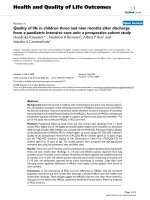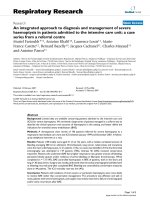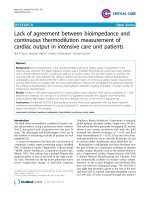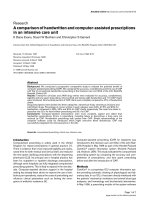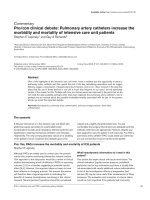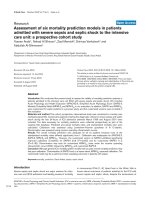ASSESSMENT OF KNOWLEDGE AND PRACTICE OF INTENSIVE CARE UNIT NURSES TOWARDS OPEN ENDOTRACHEAL SUCTIONING FOR MECHANICALLY VENTILATED PATIENT IN FOUR SELECTED GOVERNMENT PUBLIC HOSPITALS IN ADDIS ABABA,ETHIOPIA
Bạn đang xem bản rút gọn của tài liệu. Xem và tải ngay bản đầy đủ của tài liệu tại đây (798.91 KB, 58 trang )
ASSESSMENT OF KNOWLEDGE AND PRACTICE OF INTENSIVE CARE UNIT
NURSES TOWARDS OPEN ENDOTRACHEAL SUCTIONING FOR MECHANICALLY
VENTILATED PATIENT IN FOUR SELECTED GOVERNMENT PUBLIC
HOSPITALS IN ADDIS ABABA,ETHIOPIA.
ABINET ESAYAS (B.SC)
A Thesis Submitted to
College of Health Sciences Department of Emergency Medicine and Critical Care,
Presented in Partial Fulfillment of the Requirements for the Degree of Master of
Science (Emergency Medicine And Critical Care Nursing.)
Addis Ababa University
Addis Ababa, Ethiopia
June, 2017GC
I
Addis Ababa University, College of Health Sciences Department of Emergency
Medicine and Critical Care
MSC Thesis on Assessment of knowledge and practice of Intensive care unit nurses towards
open endotracheal suctioning for mechanically ventilated patient in selected four public
Hospitals in Addis Ababa, Ethiopia 2017.
Principal investigator: Abinet Esayas (BSC)
Advisors:
●
Dr. Biruk Girma (Assistance professor of Emergency Medicine)
●
Asmamaw Abebe (BSC, MSC)
June 2017, Addis Ababa, Ethiopia
II
APPROVED BY THE BOARD OF EXAMINERS
This is to certify that the thesis prepared by Abinet Esayas, entitled: Assessment of
knowledge and practice of ICU nurses towards open endotracheal suctioning for
mechanically ventilated patients in selected four public hospitals and submitted in partial
fulfillment of the requirements of degree of Masters of Science in emergency medicine and
critical care complies with the regulation of the university and meets the accepted standards
with respect to originality and quality.
Examiners:
____________________
____________________
_______________
Full name
Rank
Signature and Date
____________________
____________________
_______________
Full name
Rank
Signature and Date
____________________
____________________
_______________
Full name
Rank
Signature and Date
____________________
____________________
_______________
Full name
Rank
Signature and Date
Advisors:
June, 2017
Addis Ababa, Ethiopia
III
Acknowledgement
First and foremost, let me thank Almighty God for unending love, care and blessing through my
entire life, especially during the tenure of this thesis. My heartfelt appreciation goes to Addis
Ababa University College of Health Science, Department of Emergency Medicine and Critical
Care for giving a chance to do this research work. Next I would like to acknowledge my advisors
Dr.Biruk Girma (Assistance professor of Emergency Medicine) and Assmamaw Abebe (BSC,
MSC) for their constructive, unreserved comments and guidance. I would also like to express my
special gratitude to my beloved family, my beloved sisters who are my blessing and always there
in need and also the intensive care unit nurses for their cooperation.
IV
Table of Contents
Acknowledgement ........................................................................................................................ IV
List of Table ............................................................................................................................... VIII
List of Figures ............................................................................................................................ VIII
List of Acronyms .......................................................................................................................... IX
ABSTRACT................................................................................................................................... X
CHAPTER ONE ............................................................................................................................. 1
1 Introduction .................................................................................................................................. 1
1.1 Background ........................................................................................................................... 1
1.2 Statement of the Problem ...................................................................................................... 3
1.3 Significance of the Study ...................................................................................................... 5
CHAPTER TWO ............................................................................................................................ 6
2. Literature Review........................................................................................................................ 6
CHAPTER THRE ......................................................................................................................... 11
3. Objectives ................................................................................................................................. 11
3.1. General Objective ............................................................................................................... 11
3.2. Specific Objectives ............................................................................................................. 11
CHAPTER FOUR ......................................................................................................................... 12
4. Methods and Materials .............................................................................................................. 12
4.1 Study Area ........................................................................................................................... 12
4.2 Study Design and Period. .................................................................................................... 12
4.3 Source Population. .............................................................................................................. 12
4.4 Study Population ................................................................................................................. 12
4.5 Eligibility Criteria ............................................................................................................... 13
4.5.1 Inclusion Criteria .......................................................................................................... 13
4.5.2 Exclusion Criteria ......................................................................................................... 13
4.6 Sample Size Determination ................................................................................................. 13
4.7 Sampling Technique ............................................................................................................ 14
4.8 Data Gathering Tool ............................................................................................................ 16
V
4.8.1 Questionnaire and Checklist ......................................................................................... 16
4.9 Data Collectors and Supervisor ........................................................................................... 16
4.10 Variables............................................................................................................................ 16
4.10.1 Dependent Variable .................................................................................................... 16
4.10.2 Independent Variable .................................................................................................. 16
4.11 Operational Definitions ..................................................................................................... 17
4.12 Data Quality Assurance..................................................................................................... 17
4.13 Data Processing and Statistical Analysis .......................................................................... 18
4.14 Dissemination and Utilization of the Result ..................................................................... 18
4.15 Ethical Consideration ........................................................................................................ 18
CHAPTER5 .................................................................................................................................. 19
5. RESULT ................................................................................................................................... 19
5.1. Socio demographic characteristics of the study population ............................................... 19
5.2. Knowledge score of adult ICU nurses on ETS for mechanically ventilated patients ........ 21
5.3 Practice score of adult ICU nurses in ETS for mechanically ventilated patients................ 24
5.3.1 Factors associated with practice ................................................................................... 26
5.4. Comparison of knowledge and practice: ............................................................................ 27
5.4.1. Prior suctioning: .......................................................................................................... 27
5.4.2. During suctioning: ....................................................................................................... 27
5.4.3. Post suctioning:............................................................................................................ 27
CHAPTE SIX................................................................................................................................ 29
6. DISSCUTION ........................................................................................................................... 29
7. STRENGTH AND LIMITATION OF THE STUDY .............................................................. 34
7.1 Strength of the study ........................................................................................................... 34
7.2 Weakness or limitations of the study .................................................................................. 34
8. CONCLUSIONS AND RECOMMENDATIONS ................................................................... 35
8.1 Conclusions ......................................................................................................................... 35
8.2 Recommendations ............................................................................................................... 36
REFERENCE................................................................................................................................ 37
ANNEXES .................................................................................................................................... 40
Annex I ...................................................................................................................................... 40
Information sheet....................................................................................................................... 40
VI
Annex II..................................................................................................................................... 41
Hospital Consent Form.............................................................................................................. 41
Annex III ................................................................................................................................... 42
Data collection sheet ................................................................................................................. 42
VII
List of Table
Table 1: Distribution of adult ICU nurses according to their socio demographic
characteristics in selected governmental hospitals in Addis Ababa, 2017 G.c…………………20
Table 2: Knowledge score result of nurses working in adult ICU in ETS
for mechanically ventilated patient in Addis Ababa, 2017G.c………………………………….22
Table3. Association between socio-demographic characteristics and knowledge of
nurse’s working in the ICU towards ETS ………..……………………………………………..23
Table 4: Observed practice score of adult ICU nurses in ETS for mechanically
ventilated patients in number and percents……………………………………………………. 25
Table 5. Association between the independent variable of nurses with their practice
………………………………………………………………………………………..................27
Table 6. Observational check list to assess practice of ICU nurse’s towards
ETS for mechanically ventilated patients…………………………………………………...…..47
List of Figures
Figure 1: Shows the schematic representation of sampling procedure ………………………….15
FIG. 2 Comparison of knowledge and practice of ICU nurses …………………………...……..28
VIII
List of Acronyms
AARC = American Association of Respiratory Care
AOR
= Adjusted odds ratio
BLH
= Black lion Hospital
BP
= Blood Pressure
COR = Crowds odds ratio
E.C
= Ethiopian Calendar
ETB = Ethiopian Birr
ETS
= Endotracheal suctioning
ETT = Endotracheal Tube
HR
= Heart Rate
ICP
= Intra Cranial Pressure
ICU
= Intensive care unit
NS
= Normal Saline
RR
= Respiration Rate
SPSS = Statistical product and social service
SRS
= Simple Random Sampling
UK
= United Kingdom
IX
ABSTRACT
Background
Endotracheal suctioning (ETS) is considered one of the most common procedures in intensive
care unit to maintain a patent airway in artificially ventilated patients. However, there are many
associated risks and complications like trauma, infection, bleeding, hypoxia, dysrhythmias and,
in extreme cases, cardiac arrest and death. Knowledge and practice of Intensive care unit nurses
towards endotracheal suctioning is directly related to minimize the above complications, improve
standard care, to promote effective/safe suctioning and to reduce length of stay in ICU. So,
assessing knowledge and practice of ICU nurses towards endotracheal suctioning is baseline to
improve well-being of intubated patients.
Objective
This study was conducted to assess knowledge and practice of Intensive care unit nurses towards
open endotracheal suctioning for mechanically ventilated patient in four selected public hospitals
Addis Ababa, Ethiopia, 2017.
Methods:
Institutional based cross sectional descriptive study was conducted. Data was collected using
structured questionnaire and observational check list. Descriptive statistics included frequency,
percentage, mean and standard deviation. Odds ratio was used to determine association between
variables. Data analysis was done using SPSS version 20.
Result: A total of 100 participants were involved in the study with 59% female. The mean age of
the participants’ was between 26-30 years and the mean scores of knowledge and practice nurses
were 11.14 and 16.11 respectively. Nearly half (51.0%) of nurses had poor knowledge and
41.0% of them had fair knowledge on endotracheal suctioning. and 80.0% had poor practice
regarding ETS. Sex had statistically significant association with knowledge (p=.008, AOR and
95% CI 3.336, 1.364- 8.161).Training on ETS had statistically significant association with
practice of nurses (p=.025, AOR & 95% of CI 3.372, 1.162-9.788).
Conclusion and Recommendation: More than half 51% of nurses had poor knowledge and
almost all 80% of nurse’s practice towards ETS was poor. Teaching intervention (especially for
females) and training to improve nurse’s knowledge and practice in the care of patients requiring
ETS is indicated.
Key word: Endotracheal suctioning, knowledge and practice.
X
CHAPTER ONE
1 Introduction
1.1 Background
Patent air way is very important for effective gas exchanges. Airway patency is naturally
maintained by action of the mucocilliary system, when normal amount of mucus is produced by
local immune system and by cough reflex. When patient is critically ill this function may be
compromised and lead to excessive pulmonary secretions. Airway clearance cannot be
accomplished via involuntary physiological mechanism then collaborative nursing intervention is
mandatory such as, endotracheal suctioning to maintain patient airway (1).
Open endotracheal suctioning refers to a single use catheter inserted in to the artificial air way
either by disconnecting the ventilator or swivel connector (2).endotracheal suctioning (ETS) is
one of the most essential activities performed in patients with artificial airways. It’s one of the
methods of bronchial hygiene therapy and mechanical ventilation which involves the mechanical
aspirations of pulmonary secretions from patient’s endotracheal tube to prevent its obstruction
and to support breathing (3).
ETS is also a mechanism of removing secretions from patient’s lung with applying negative
pressure by inserting catheter through endotracheal tube. This procedure prevents accumulation
of pulmonary secretions, keep airway patency and ensure optimal oxygenation and ventilation, as
well as it save lifes.ETS has some life threatening complications such as hypoxia, ventilator
associated pneumonia ,Bronchospasm , increased intracranial pressure ,tracheal tissue damage,
atelectasis and cardiac dysrhythmias. So, all intensive care unit nurses should be aware of
possible complications of patients go through when performing ETS. Therefore, assessing ETS
knowledge and practices is vital in order to reduce the incidence (4).
ETS is considering one of the most essential procedures performed for patients with
mechanically ventilated (4). Most patients expressed it painful and uncomfortable and it may
brought choking sensation initiating involuntary cough and vomiting and also cause an
unpleasant sensation when the lungs are being suctioned by catheter (5).
1
Despite complain, patients also told that the procedure is mandatory and help them to breathe
easily. The pain and discomfort of suctioning doesn’t improve during the duration of mechanical
ventilation; on the opposite it become worst (6).
ETS for ventilated and intubated patients is a basic and routine nursing procedure, but practices
differ among clinicians and hospitals. Sometimes, lack of research evidence doesn’t necessarily
mean that practice is no use. Alternatively, there may be some practice like instillation of normal
saline, that continue even when actual evidence clearly indicates either no use or potential harm
(7).
ETS is a sterile procedure that nurse must follow sterile technique to prevent infection. Nurse’s
lack of knowledge and practical skill of aseptic technique in this area leads patient to infection
and cross infection .This is one of the contributing factors of long stay in hospital which results
in more morbidity and mortality.
The aim of this study is to assess the knowledge and practice of ICU nurses regarding to ETS in
selected governmental hospitals Addis Ababa, Ethiopia 2017.
2
1.2 Statement of the Problem
Mechanical ventilation is an important life support treatment given to patients admitted in ICU.
Beside from requiring a specialized equipments and strategies, trained health care professionals
are also needed to provide care for mechanically ventilated patients. Association of all these
elements is essential for better care (8). Patients who are on the mechanical ventilator have to get
a more complex, well structured and technically sophisticated level of care. Every year there are
several hundreds of research papers published that help professionals to up-to-date the
physiology and pathophysiology of patients and also how treatment approach should be to make
different in a patient progression(9).
ETS is one of the main procedures performed in ICU (2).According to some studies that
intubated patients may need ETS 3 to 24 times in each 24 hours (10). ETS have several
complications and side effects if it is not applied with appropriate technique. Which may lead to
infection, trachea endothelial trauma, bleeding, increased in intracranial pressure, respiratory
arrest, hypoxemia and cardiac dysrhythmias and further it cause cardiac arrest and death(2).
Because of the above life threatening condition ETS should follow right standards and codes to
minimize its side effects (7). According to patient need, well trained nurse brings better result
and minimize its risk rather than doing it routinely (11). And also revealed study show that
performing suctioning according to standard protocol will minimize its complication (12).despite
the fact of many studies, guidelines or manual about ETS is not found in most ICUs
(13).Therefore, without guidelines practicing suctioning
with in experimental way is on
question(14).
Studies in intense and acute care units, confirmed that nurses poor knowledge is reflected on
their practice (15). Research showed that there is big gap between nurse’s knowledge and
practice of ETS. According to the research their knowledge was much better than their practice
and it was not reflected in their practice (14). ETS practice varies from nurse to nurse and did not
follow experimental recommendations so the quality of care was lower than expected (16).
Regarding the importance of performing ETS correctly in ICU, researches should take place to
assess ICU nurses knowledge and practice to find the gap on ETS related knowledge and
3
practice because none can be said about ETS for mechanically ventilated patients in Ethiopia as
there are no studies so far.
Without guidelines, a protocol and research based findings it is difficult to achieve critical
patient need and see good outcome. So, assessing the knowledge and practice of ICU nurses in
this topic is important to maintain patients well being.
4
1.3 Significance of the Study
To certain the highest standards of nursing care, nursing practice must be based on a strong
scientific knowledge and practice. This can be achieved through adherence to the evidence based
guidelines for prevention of ETS associated complication, eventually improving patients out
come. Standard ETS practice will shorten patients ICU stay and hospitalization. Further, related
infection like, VAP which is linked with more cost, morbidity and mortality in mechanically
ventilated patients.
Considering that the critical patient in the ICU, in most cases in the state of use of endotracheal
tube or artificial airway, it’s important to assess nurse’s knowledge and practice of ETS. By
raising data on knowledge and practice of ICU nurses on ETS, demonstrating the importance of
this resource in ICU, and also contribute the development of protocols which aimed at
prevention of complication and to draw baseline data with the gap to the future improvement of
ETS knowledge and practice so as to maintain patients well being is the reason of this study.
5
CHAPTER TWO
2. Literature Review
Endotracheal suctioning is used to remove pulmonary secretions, to clear respiratory tract,
maintain oxygenation and avoid atelectasis. ETS is most frequent invasive procedure that
performed in patients with mechanically ventilated (2,16). Unsafe ETS practice like, inadequate
infection control practices and the prevention of possible aspiration of colonized Oropharyngeal
secretions is the main treatment associated risk factors in the pathogenesis of ventilator
associated pneumonia(VAP) by facilitating microbial colonization of the lower airways (2,17).
In previous descriptive, observational (Joanna Briggs Institute report) (18) and co relational
studies, ETS practices have been evaluated in relation to recent recommendations (15,18). Even
without strong evidence, unsafe practices have been notice globally over the past view years.
Significant discrepancies have been observed in practice before (eg, patient assessment, and
preparation, hyper oxygenation), during (eg, use of appropriate size catheter, infection control
practice, the level of negative pressure) and post ETS (eg, monitoring vital sign, patient
reassurance) (16). Nurses should be care full to minimize risk of adverse reaction such as,
infection, hypoxemia and hemodynamic alterations, atelectasis, barotraumas and Bronchospasm
and in the same time to ensure patient safety and the quality of nursing care(2).
An article reviews about ETS in adult intubated intensive patients need to provide research based
recommendations. Suctioning only when necessary, using lowest suction pressure, a suction
catheter occluding less than half the lumen of endotracheal tube, suctioning only for 10 to 15s,
inserting the catheter no further than carina, hyperinflation and hyper oxygenation, performing
continues rather than intermittent suctioning, avoiding saline lavage, providing hyper
oxygenation before and after the suction procedure, always using aseptic technique, when using
open suction system are the main and major recommendation of researcher (7).
A study conducted in India, to assess the knowledge and skill of critical care nurses on ETs in 8
ICU by using non probability convenience sampling technique in 50 nurses, and results revealed
that 70% had an acceptable level of knowledge, 64% had least acceptable knowledge on the
suction event and 54% on post suctioning period. An acceptable level of skill in performing ETS
56% of nurse, but skill in practices prior suctioning was least acceptable 86%. A significant
6
difference (P < 0.001) was obtained between the current practice observed and the best
suggested practice on ETS. Auscultation of chest (2%), posts suctioning assessment (2%),
wearing apron (6%), reassuring the patient before (30%) and after suctioning (18%), maintaining
suction pressure (10%), time of suction applied (36%), maintaining the suction catheter’s sterility
(46%) and hand washing before (42%) and after suctioning (28%) were not practiced in most
nurses. The conclusion, nurses had acceptable level of knowledge but practices various during
ETS. Training is needed to improve nurse’s practice (21).
A study conducted in India, to assess the level of knowledge on ETS among staff nurses and
student nurses by using descriptive cross sectional design and convenient sampling technique
was followed which included 30 samples , result shows that with regard to level of knowledge
ETS among staff nurses 1(7%) had inadequate knowledge , 11(73%) had moderate knowledge ,
and 3(20%) had adequate knowledge . among nursing students 3(20%) had in adequate
knowledge , and 12(80%) had moderate knowledge (23).
A study conducted in Trivandrum (India), sreechitratirunal institute for medical science and
technology, to assess the knowledge and practice of ETS among 30 Neuron nurses by
observational checklist and by using questionnaire. Outcome of the result was the knowledge
score of staff nurses with less ICU experience ranged from 10 to 14 with a mean of 12.06(1.48).
The knowledge of staff nurses with more ICU experience ranged from 11 to 14 with a mean of
12.08 (1.19). There was no statistically significant differences in the mean knowledge score of
both group. Thirty ETS episode of 19 staff nurses both permanent and temporary were observed
during all three shifts. However there was no statistically difference in the in the mean practice
score of both groups. Based on the findings of the study Neuron nurses have average knowledge
about ETS but in practice they are not practicing critical care elements (24).
The study conducted in IRAN by using cross sectional study of knowledge and performances of
44 nurses working in 3 ICUs in shahid beheshti hospital, kasha, Iran ,which was evaluated in
prior, during and post suctioning, by using a 26 questionnaire and checklist in 2010 and the result
showed that in the 8 items in question of prior suction the average score for knowledge and
practice were 5.4(± 1.12 ) and 0.81 (± 0.71) respectively and the investigation of ten items
during suction an average score of 7.7(±1.09) and 4.6(± 0.75) were gained for knowledge and
practice respectively . In 8 items of post suction the average score of knowledge was 6.47
(±0.69) and that of performance was 3.86. In general, from 26 possible points, the average score
of knowledge and practice were 19.59 and 8.75 respectively. The type of ICU and nurses
working experience were not significantly related to their knowledge and practice. The study
7
revealed that regardless of acceptable knowledge, nurse’s practice on ETS is poor. This shows
that education without practice doesn’t meet the standards (22).
A structured, non participatory, observational study conducted in institute of health sciences,
university of Oulu, Finland, by using a 25-item best practice checklist to assess ICU nurse’s ETS
practices in medical-surgical ICU. And also used to evaluate ICU nurses ETS performance
against current recommendations within different ICU experience groups. Unfortunately,
observed ETS practice quality is lower than needed (p less than 0.001) infection control practice
is one of the lower quality observed aria (4).
A descriptive study was done in Spain, in 34 nurses and analyzed by direct observation just
looking their ETS practice, using the collection of a structured grid which contains 19 portions to
measure, divided in to 6. Final conclusion of the study was, studied nurses have good scientific
knowledge about ETS and it is much better than their practical skill. Different between
knowledge and practice were also in evaluation, so training on the procedure must to fill the gap
(14).
A study conducted in London to examine nurse’s knowledge and ability when in practicing ETS
in ICU and needed ward arias to search differences between practice and knowledge of 28 nurses
in UK by using a structured interview and questionnaire. Poor level of knowledge was scored in
many arias. This study recommended that ETS needs clinical guidelines and practice should be
based on training (15).
Study conducted in UK to check ICU nurses knowledge and practice of ETS is based on recent
research, to relate uses of research based teaching on nurse’s knowledge and practice
experimental study was a randomized, controlled, single-blinded comparison of two research
based teaching programs. In 16 ICU nurses, using non participant observation and a self
administer questionnaire. Result showed that most participant have poor knowledge, which
affect their practice too, if suctioning was performed against many of the research
recommendations. Teaching and training brings significant improvements on both knowledge
and practice (13).
The study done in Italy, to assess ICU nurses knowledge about ETS guidelines of American
Association of Respiratory care (AARC, 2010) in different hospitals. All of 379 nurses receive
questionnaire. Only 65%of questionnaire returned complete. Nobody can get answer without
8
mistake 58% is maximum score to get the right answer .the total percentage of correct answers
was 58%. In addition, only 2.5(n=6) of the nurses gave9/10 correct answers. Experienced ICU
nurses score more correct answer. Italian ICU nurses knowledge of guidelines on endotracheal
suctioning was not enough; however, experienced nurses demonstrated a better knowledge of the
subject (19).
A cross sectional and non-participants structured observational design study conducted in
western Turkey, to determine ICU nurses knowledge and practice levels regarding open system
endotracheal suctioning and to investigate if there is a relationship between nurses demographic
characteristics and their knowledge and practice on 72 nurses of 3 adult ICU teaching hospitals
show that, the nurses mean score of knowledge and practice were23.79±3.83 and 12.88±2.53.
Their level of knowledge was very good in 59.7%, good in 34.7%, and the level of practice was
fair in 79.2% and good in18.1%. The relationship between the type of unit and the nurses
knowledge scores was statistically significant (p=0.013). The correlation between the nurses
score of knowledge and practice was not statistically significant(r=0.220; p=0.063). This study
suggests that knowledge level of most of the nurses was good and their practice level was fair
ICU nurses has responsibility to demonstrate safe practice during suctioning to give standard
care for the patient and to minimize complications (20).
In Ireland, on March 2005, as structured observational study was conducted using a, piloted 20
item observational schedule, on two adult ICU to determine critical care nurses (N=45)
endotracheal suctioning procedure in their day to day practice to establish endotracheal
suctioning guidelines applied or not. All participants have different practical skill and that
indicates nurses didn’t use practical guidelines recommendation because of this they provide
lower quality below the expectation. Considerable differences were observed in participant’s
respiratory assessment technique, hyper oxygenation and infection control, patient reassurance
and the level of negative pressure used to clear secretions. Findings suggest that critical care
nurses do not committed to apply the best practice recommendations when performing ETS. The
result of this study offer an Irish/European perspective on critical care nurse’s day to day
suctioning practice (16).
A descriptive cross sectional hospital based study conducted in Khartoum, Sudan to assess
knowledge and practice of ICU nurses regarding mechanically ventilated patients ETS, in a total
of (42 nurses) results showed that the majority of nurses working in Khartoum teaching hospital
9
(85.7%) have poor knowledge level, (76.7%) have faire practice level. Nurses have better
practice level than knowledge level (25).
10
CHAPTER THRE
3. Objectives
3.1. General Objective
The general objectives of this study was to assess knowledge and practice of Intensive care unit
nurses towards open Endotracheal suctioning for mechanically ventilated patient in four selected
public hospital in Addis Ababa, Ethiopia 2017.
3.2. Specific Objectives
1. To assess knowledge of endotracheal suctioning for mechanical ventilated patient of ICU
nurse’s.
2. To assess practice of endotracheal suctioning for mechanical ventilated patient of ICU nurse’s
11
CHAPTER FOUR
4. Methods and Materials
4.1 Study Area
Addis Ababa is capital city of Ethiopia, and seat of African Union and Economic Commission
for Africa is at the heartland of Ethiopia, with a population of 3.384,569 in an aria of 540 square
kilometers. The city comprises 6 zones and 28 wordas. The population pyramid is broad based,
typically of a developing world. People from different regions of Ethiopia populate the city; the
main causes of morbidity and mortality are communicable diseases that could be prevented
through interaction of primary health care activities. The city consists of a total of 79 health
facilities including Hospitals; out of which 5 hospitals owned by Addis Ababa Health Bureau,4
hospitals owned by Federal Ministry of Health (central), 1 Addis Ababa University, 2 ministry of
defense, 1 police force hospitals which provide different health services. In addition there are
about 23 health center, 9 clinic, and 34 health posts. Among 8 public hospitals, Black Lion
Specialized Hospital, St. Pawulose, Aabet, and Yekatit 12 were selected by lottery method. The
study conducted in these four hospitals (ICU) from December 2017 to June 2017 Addis Ababa,
Ethiopia.
4.2 Study Design and Period.
Institutional based cross sectional descriptive study was used to assess knowledge and practice of
ICU nurses towards ETS for mechanically ventilated patient in four selected public hospitals of
Addis Ababa from December to June 2017.
4.3 Source Population.
All nurses working in public hospitals ICU of Addis Ababa.
4.4 Study Population.
All nurses working in the four selected public hospitals ICUs during the data collection period
that fulfilled the inclusion criteria.
12
4.5 Eligibility Criteria
4.5.1 Inclusion Criteria
● Nurses who were working in ICU for 6 months and above.
● Nurses who were available on the study time and
● Volunteer to participate in the study during the study period were included.
4.5.2 Exclusion Criteria
Nurses who were not available during the study period.
Nurses with less than 6 months of work experience.
4.6 Sample Size Determination
The sample size of the study was calculated by using a single proportion formula
[ no=(Zα/2)2P(1-P)/d2]. According to Elbokhary et al., 2015 ‘P’ 0.143 was taken for the study.
Z= standard normal deviation of 1.96 corresponding to 95% confidence interval
P= Prevalence rate= 0.143.
D= degree of accuracy of the result=0.05
no = no=(Zα/2)2P(1-P)/d2
= (1.96)2 0.143(0.857)
N= 176(unpublished data from the hospitals human resources
(0.05)2
data)
no = 188
Since the population is less than 10,000 the study used the correction formula
nf = no x N
no+N
= 188 x 176
188 + 176
= 91
To adjust non respondent rate 10% contingency was added and the final sample size was 100
ICU nurse.
13
4.7 Sampling Technique
There are thirteen (13) government hospitals of which 10 are public hospitals. Of the ten public
hospitals eight (8) have ICU set up. From 8 hospitals four were selected by lottery method. These
are (Black lion, Aabet, St.Paulos and Yekatit 12).
Proportional to size allocation formula = ni x nf
n
Where: ni - number of nurse in hospital
nf - final sample of the study
n- total number of nurse in the selected hospitals
Black lion Hospital (BLH) = 37 x 100/124 = 30
Aabet hospital = 40x 100/124 = 32
St. Paul hospital = 27 x100/124 = 22
Yekatit 12 hospital= 20 x 100/124= 16
The schematic presentation of the sampling method is described in next page:
14
Government Hospitals (n=13)
Public Hospitals (n=10)
Military Hospitals (n=3)
S.R.S (n=124)
Simple Random Sampling (nf=100)
n= 30
n=32
n=30
n=22
n=16
Figure 1: Shows the schematic representation of sampling procedure
15
ALERT (n=7)
Minilik H
(n=14)
Zewditu H
(n=15)
Ras Desta H
(n=16)
Yekatit 12(n=20)
St.Paul H (n=27)
Aabet H (n=40)
BLH (n=37)
S.R.S (n=8) (N=176 nurses)
